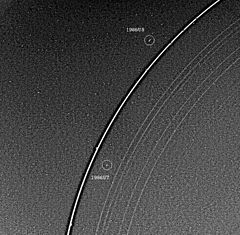Cordelia (moon): Difference between revisions
m robot Adding: eo:Kordelio (luno) |
m Removed "Unfortunately" from the beginning of the second paragraph -- the sentiment implies editorial judgment ~~~~ |
||
| Line 43: | Line 43: | ||
'''Cordelia''' ({{pron-en|kɔrˈdiːliə}} {{respell|kor|DEE|lee-ə}}) is the [[inner satellite|innermost moon]] of [[Uranus]]. It was discovered from the images taken by ''[[Voyager 2]]'' on January 20, 1986 and was given the temporary designation '''S/1986 U 7'''.<ref>{{cite web|last=Smith|first=B. A.|title=IAU Circular No. 4168|date=1986-01-27|url= http://cfa-www.harvard.edu/iauc/04100/04168.html#item1|accessdate=2006-08-06}}</ref> It was not detected again until the [[Hubble Space Telescope]] observed it in 1997.<ref name="Karkoschka2001a"/><ref>{{cite web|last=Showalter|first=M. R.|coauthors=Lissauer, J. J.|title=IAU Circular No. 8194|date=2003-09-03|url=http://cfa-www.harvard.edu/iauc/08100/08194.html|accessdate=2006-08-05}}</ref> Cordelia takes its name from the youngest daughter of Lear in [[William Shakespeare]]'s ''[[King Lear]].'' It is also designated '''Uranus VI'''.<ref name="Gazetteer">{{cite web|title=Planet and Satellite Names and Discoverers|work=Gazetteer of Planetary Nomenclature|publisher= USGS Astrogeology|date=2006-07-21|url=http://planetarynames.wr.usgs.gov/append7.html|accessdate=2006-08-06}}</ref> |
'''Cordelia''' ({{pron-en|kɔrˈdiːliə}} {{respell|kor|DEE|lee-ə}}) is the [[inner satellite|innermost moon]] of [[Uranus]]. It was discovered from the images taken by ''[[Voyager 2]]'' on January 20, 1986 and was given the temporary designation '''S/1986 U 7'''.<ref>{{cite web|last=Smith|first=B. A.|title=IAU Circular No. 4168|date=1986-01-27|url= http://cfa-www.harvard.edu/iauc/04100/04168.html#item1|accessdate=2006-08-06}}</ref> It was not detected again until the [[Hubble Space Telescope]] observed it in 1997.<ref name="Karkoschka2001a"/><ref>{{cite web|last=Showalter|first=M. R.|coauthors=Lissauer, J. J.|title=IAU Circular No. 8194|date=2003-09-03|url=http://cfa-www.harvard.edu/iauc/08100/08194.html|accessdate=2006-08-05}}</ref> Cordelia takes its name from the youngest daughter of Lear in [[William Shakespeare]]'s ''[[King Lear]].'' It is also designated '''Uranus VI'''.<ref name="Gazetteer">{{cite web|title=Planet and Satellite Names and Discoverers|work=Gazetteer of Planetary Nomenclature|publisher= USGS Astrogeology|date=2006-07-21|url=http://planetarynames.wr.usgs.gov/append7.html|accessdate=2006-08-06}}</ref> |
||
Other than its orbit,<ref name=Jacobson1998/> radius of 20 km<ref name="Karkoschka2001b"/> and geometric albedo of 0.08<ref name="Karkoschka2001a"/> virtually nothing is known about it. At the Voyager 2 images Cordelia appears as an elongated object, the major axis pointing towards Uranus. The ratio of axises of the Cordelia's prolate spheroid is 0.7 ± 0.2.<ref name="Karkoschka2001b"/> |
|||
Cordelia acts as the inner [[shepherd satellite]] for Uranus' [[rings of Uranus|Epsilon ring]].<ref name=Esposito2002>{{cite journal |last=Esposito |first=L. W. |authorlink=Larry W. Esposito |title=Planetary rings |journal=Reports On Progress In Physics |year=2002 |volume=65 |pages=1741–1783 |url=http://www.iop.org/EJ/abstract/0034-4885/65/12/201 |doi=10.1088/0034-4885/65/12/201}}</ref> Cordelia's orbit is within Uranus' synchronous orbit radius, and is therefore slowly decaying due to [[tidal deceleration]].<ref name="Karkoschka2001b"/> |
Cordelia acts as the inner [[shepherd satellite]] for Uranus' [[rings of Uranus|Epsilon ring]].<ref name=Esposito2002>{{cite journal |last=Esposito |first=L. W. |authorlink=Larry W. Esposito |title=Planetary rings |journal=Reports On Progress In Physics |year=2002 |volume=65 |pages=1741–1783 |url=http://www.iop.org/EJ/abstract/0034-4885/65/12/201 |doi=10.1088/0034-4885/65/12/201}}</ref> Cordelia's orbit is within Uranus' synchronous orbit radius, and is therefore slowly decaying due to [[tidal deceleration]].<ref name="Karkoschka2001b"/> |
||
Revision as of 23:13, 19 May 2010
 Cordelia (lower-middle, inside of bright ring), discovery image from Voyager 2 | |
| Discovery | |
|---|---|
| Discovered by | Richard J. Terrile / Voyager 2 |
| Discovery date | January 20, 1986 |
| Orbital characteristics | |
Mean orbit radius | 49751.722 ± 0.149 km[1] |
| Eccentricity | 0.00026 ± 0.000096[1] |
| 0.33503384 ± 0.00000058 d[1] | |
| Inclination | 0.08479 ± 0.031° (to Uranus' equator)[1] |
| Satellite of | Uranus |
| Physical characteristics | |
| Dimensions | 50 × 36 × 36 km[2] |
| 20.1 ± 3 km[2][3][4] | |
| ~5500 km²[5] | |
| Volume | ~38,900 km³[5] |
| Mass | ~4.4×1016 kg[5] |
Mean density | ~1.3 g/cm³ assumed[3] |
| ~0.0073 m/s²[5] | |
| ~0.017 km/s[5] | |
| synchronous[2] | |
| zero[2] | |
| Albedo | 0.08 ± 0.01 [6] 0.07[3][4] |
| Temperature | ~64 K[5] |
Cordelia (Template:Pron-en kor-DEE-lee-ə) is the innermost moon of Uranus. It was discovered from the images taken by Voyager 2 on January 20, 1986 and was given the temporary designation S/1986 U 7.[7] It was not detected again until the Hubble Space Telescope observed it in 1997.[6][8] Cordelia takes its name from the youngest daughter of Lear in William Shakespeare's King Lear. It is also designated Uranus VI.[9]
Other than its orbit,[1] radius of 20 km[2] and geometric albedo of 0.08[6] virtually nothing is known about it. At the Voyager 2 images Cordelia appears as an elongated object, the major axis pointing towards Uranus. The ratio of axises of the Cordelia's prolate spheroid is 0.7 ± 0.2.[2]
Cordelia acts as the inner shepherd satellite for Uranus' Epsilon ring.[10] Cordelia's orbit is within Uranus' synchronous orbit radius, and is therefore slowly decaying due to tidal deceleration.[2]
References
- ^ a b c d e Cite error: The named reference
Jacobson1998was invoked but never defined (see the help page). - ^ a b c d e f g Cite error: The named reference
Karkoschka2001bwas invoked but never defined (see the help page). - ^ a b c "Planetary Satellite Physical Parameters". JPL (Solar System Dynamics). 2008-10-24. Retrieved 2008-12-12.
- ^ a b Williams, Dr. David R. (2007-11-23). "Uranian Satellite Fact Sheet". NASA (National Space Science Data Center). Retrieved 2008-12-12.
- ^ a b c d e f Calculated on the basis of other parameters
- ^ a b c Cite error: The named reference
Karkoschka2001awas invoked but never defined (see the help page). - ^ Smith, B. A. (1986-01-27). "IAU Circular No. 4168". Retrieved 2006-08-06.
- ^ Showalter, M. R. (2003-09-03). "IAU Circular No. 8194". Retrieved 2006-08-05.
{{cite web}}: Unknown parameter|coauthors=ignored (|author=suggested) (help) - ^ "Planet and Satellite Names and Discoverers". Gazetteer of Planetary Nomenclature. USGS Astrogeology. 2006-07-21. Retrieved 2006-08-06.
- ^ Esposito, L. W. (2002). "Planetary rings". Reports On Progress In Physics. 65: 1741–1783. doi:10.1088/0034-4885/65/12/201.
